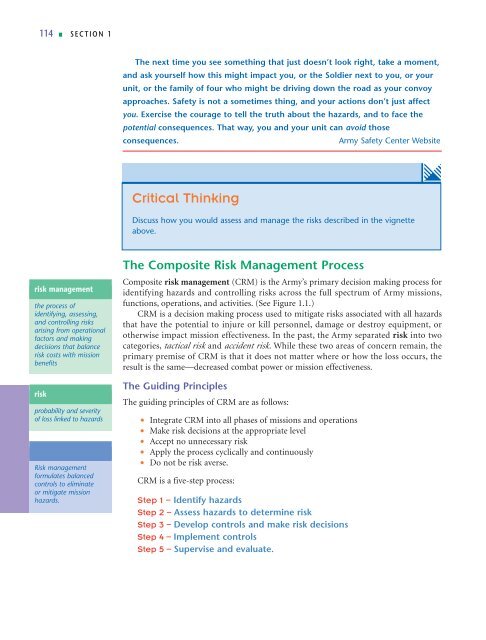Composite Risk Management.pdf - UNC Charlotte Army ROTC
Composite Risk Management.pdf - UNC Charlotte Army ROTC
Composite Risk Management.pdf - UNC Charlotte Army ROTC
- No tags were found...
You also want an ePaper? Increase the reach of your titles
YUMPU automatically turns print PDFs into web optimized ePapers that Google loves.
114 ■ SECTION 1The next time you see something that just doesn’t look right, take a moment,and ask yourself how this might impact you, or the Soldier next to you, or yourunit, or the family of four who might be driving down the road as your convoyapproaches. Safety is not a sometimes thing, and your actions don’t just affectyou. Exercise the courage to tell the truth about the hazards, and to face thepotential consequences. That way, you and your unit can avoid thoseconsequences.<strong>Army</strong> Safety Center WebsiteCritical ThinkingeDiscuss how you would assess and manage the risks described in the vignetteabove.risk managementthe process ofidentifying, assessing,and controlling risksarising from operationalfactors and makingdecisions that balancerisk costs with missionbenefitsriskprobability and severityof loss linked to hazards<strong>Risk</strong> managementformulates balancedcontrols to eliminateor mitigate missionhazards.The <strong>Composite</strong> <strong>Risk</strong> <strong>Management</strong> Process<strong>Composite</strong> risk management (CRM) is the <strong>Army</strong>’s primary decision making process foridentifying hazards and controlling risks across the full spectrum of <strong>Army</strong> missions,functions, operations, and activities. (See Figure 1.1.)CRM is a decision making process used to mitigate risks associated with all hazardsthat have the potential to injure or kill personnel, damage or destroy equipment, orotherwise impact mission effectiveness. In the past, the <strong>Army</strong> separated risk into twocategories, tactical risk and accident risk. While these two areas of concern remain, theprimary premise of CRM is that it does not matter where or how the loss occurs, theresult is the same—decreased combat power or mission effectiveness.The Guiding PrinciplesThe guiding principles of CRM are as follows:• Integrate CRM into all phases of missions and operations• Make risk decisions at the appropriate level• Accept no unnecessary risk• Apply the process cyclically and continuously• Do not be risk averse.CRM is a five-step process:Step 1 – Identify hazardsStep 2 – Assess hazards to determine riskStep 3 – Develop controls and make risk decisionsStep 4 – Implement controlsStep 5 – Supervise and evaluate.
















